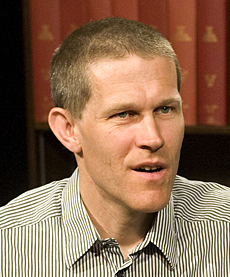- Speaker
- Prof. Steve Wereley
- School of Mechanical Engineering, Purdue University, USA
- Abstract
Recently my research group in the Microfluidics Laboratory at Purdue University has developed several innovative technologies with potential applications in the bio/medical/chemical/pharma industries. These are (i) droplet-based microfluidics, (ii) opto/electric droplet manipulation, and (iii) opto/electric particle manipulation. I will present the fundamental principles behind these methods, what their capabilities are, and what their potential uses are. The talk will review:
(i) Droplet-based microfluidics: we have developed all on-chip methods of pumping, mixing, and combinatorial chemistry. The most exciting recent development is our ability to produce a sequence of hundreds of droplets with a gradient of a desired compound. This sequence of droplets can cover 4-6 orders of magnitude in the concentration of the compound and enables effective on-chip combinatorial chemistry. This technology is quite useful for constructing dose/response curves while consuming a minimum of potentially expensive samples and reagents as well as for minimizing human or even robotic involvement in constructing dose/response curves.
(ii) Opto/electric droplet manipulation: using lasers and electric fields we can control and manipulation individual droplets to perform assays and other chemical operations. This method is similar to opto-electrowetting (OEW or EWOD) except that the “electrodes” used for the droplet manipulation are virtual electrodes whose locations are defined by dynamic laser light patterns rather than fixed, unmovable conventional electrodes.
(iii) Opto/electric particle manipulation: using lasers and electric fields we can capture, concentrate, manipulate and sort populations of micro- and nanometer-scaled “particles”. The “particles” range in size from single molecules (DNA, proteins, etc.) to nanoparticles (quantum dots, carbon nanotubes, nano-scaled polystyrene latex beads, etc.) to biological organisms (bacteria, mammalian cells, etc.). This novel technique combines features of optical trapping (OT) and dielectrophoresis (DEP) in an innovative, dynamic way using a simple parallel plate electrode configuration. Transparent electrodes comprised of Indium Tin Oxide (ITO) on glass substrates apply an electric field to the fluid carrying the particles but also to allow light into and out of the fluid. Near-IR laser illumination causes subtle localized heating, creating an electric permittivity gradient that in turn drives a microscopic toroidal vortex. The vortex efficiently transports particles to a preferred location, usually the surface of the electrode.
- About the Speaker
Professor Wereley completed his masters and doctoral research at Northwestern University. He joined the Purdue University faculty in August of 1999 after a two-year postdoctoral appointment at the University of California Santa Barbara. During his time at UCSB he worked with a group developing, patenting, and licensing to TSI, Inc., the micro-Particle Image Velocimetry technique. His current research interests include designing and testing microfluidic MEMS devices, investigating biological flows at the cellular level, improving micro-scale laminar mixing, and developing new micro/nano flow diagnostic techniques. Professor Wereley is the co-author of Fundamentals and Applications of Microfluidics (Artech House, 2002 and 2006) and Particle Image Velocimetry: A Practical Guide (Springer, 2007). He is on the editorial board of Microfluidics and Nanofluidics Journal and Experiments in Fluids and is an Associate Editor of Springer’s Microfluidics and Nanofluidics. Professor Wereley has edited Springer's recent Encyclopedia of Microfluidics and Nanofluidics and Kluwer's BioMEMS and Biomedical Nanotechnology.
- Date&Time
- 2016-06-17 9:30 AM
- Location
- Room: A203 Meeting Room




